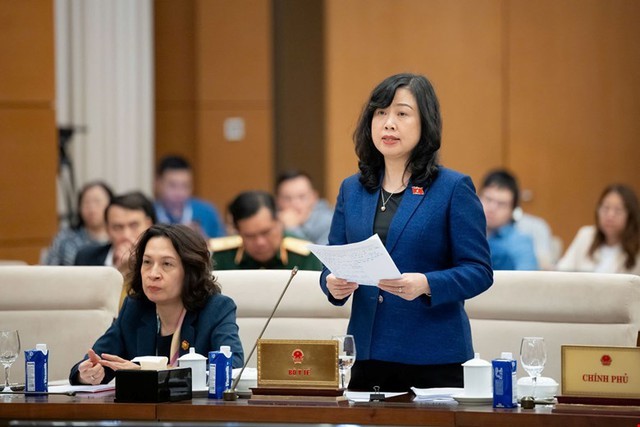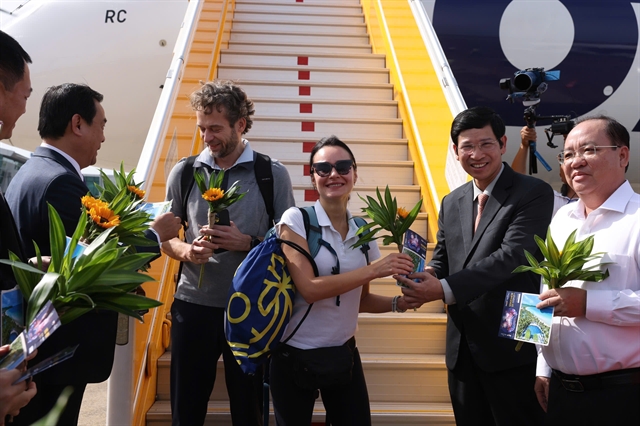 Society
Society


|
| Health Minister Đào Hồng Lan presents the National Assembly a report explaining a proposal on investment policy for the National Target Programme on Healthcare, Population and Development for the period 2026–2035. VNA/VNS Photo |
HÀ NỘI – The Ministry of Health has submitted to the National Assembly Standing Committee (NASC) a proposal on the investment policy for the National Target Programme on Healthcare, Population and Development for 2026–2035.
According to Minister of Health Đào Hồng Lan, the programme aims to improve the physical and mental health, stature, life expectancy and quality of life of the population; ensure all citizens receive quality primary healthcare management and services; and encourage individuals to take initiative in protecting and enhancing their own health.
Lan said the programme also seeks to limit disease incidence through early and localised prevention; address priority population issues; proactively adapt to population ageing; improve population quality; and enhance care for vulnerable groups, contributing to building a healthy and prosperous Việt Nam in the new era.
The programme sets out specific objectives. These include increasing the proportion of communes, wards and special zones meeting the National Criteria for Commune Health to 90 per cent by 2030 and 95 per cent by 2035. It aims to ensure 100 per cent of citizens have electronic health records and lifecycle health management by 2030 and maintain this rate to 2035. All provincial centres for disease control (CDCs) are to be capable of testing pathogens, antigens and antibodies of dangerous infectious diseases and assessing clean water quality and school sanitation by 2030.
The programme also seeks to ensure all commune, ward and special-zone health stations nationwide implement prevention, management and treatment of selected non-communicable diseases fully in line with issued protocols by 2030 and maintain this rate to 2035. It aims to reduce stunting among children under five to below 15 per cent by 2030 and below 13 per cent by 2035. By 2030, 50 per cent of citizens should access at least one official mass media channel on primary healthcare, disease prevention and health promotion, rising to 80 per cent by 2035.
The objectives include increasing the crude birth rate by 0.5 per mille by 2030 compared with 2025, and by a further 0.5 per mille by 2035 compared with 2030. The programme aims to reduce the sex ratio at birth to below 109 boys per 100 girls by 2030 and below 107 boys per 100 girls by 2035. It seeks to ensure 90 per cent of couples receive pre-marital counselling and health examinations by 2030 and 95 per cent by 2035.
Additionally, 70 per cent of pregnant women are to undergo screening for at least four common congenital disorders, and 90 per cent of newborns are to be screened for at least five common congenital disorders. The programme also aims to increase by 70 per cent the number of vulnerable and at-risk people accessing and using services at social care facilities.
The programme consists of five component projects: strengthening the capacity of the primary healthcare network; improving the effectiveness of disease prevention and health promotion; population and development; improving the quality of social care for vulnerable groups; and health communication, management, monitoring and supervision of programme implementation.
It aligns closely with directives of the Politburo under Conclusion No. 149-KL/TW dated April 10 and Resolution No. 72-NQ/TW dated September 9, as well as guidance from the General Secretary under Notice No. 176-TB/VPTW dated April 25.
The programme ensures focus, feasibility and prioritisation, avoids fragmentation, overlap or duplication with existing investment and recurrent spending tasks already funded by the State Budget and does not duplicate national target programmes or other approved programmes, projects or policies for 2026–2035.
Reviewing the submission, Nguyễn Đắc Vinh, chair of the NA’s Committee for Culture and Social Affairs, said the NASC agreed on the need to develop the programme to institutionalise the Party’s policy on improving healthcare quality, population work and development.
The programme meets the requirements for deciding investment policy under the Law on Public Investment.
Regarding beneficiaries, the committee recommended adding persons with disabilities as a priority group and adjusting provisions on priority beneficiaries by assigning the Government to specify detailed regulations. This would ensure full alignment with the spirit of Resolution No. 72 and facilitate implementation.
On overall funding, the committee requested that the Government allocate sufficient minimum resources, promote social mobilisation, and continue to consider and supplement resources where conditions allow. For local budgets, it requested careful assessment of mobilisation capacity and more realistic capital allocation levels.
In terms of objectives, the committee proposed further review of general and specific objectives and operational content of each sub-project to ensure consistency, logical flow, alignment with results-based management principles, and ease of monitoring, inspection and evaluation of socio-economic effectiveness.
For the programme’s projects, the committee recommended reviewing and selecting core activities to avoid dispersal and inefficient use of resources. Objectives, tasks and solutions of each sub-project must be consistent with overall and specific objectives, include clear indicators and be easy to monitor and evaluate. VNS




